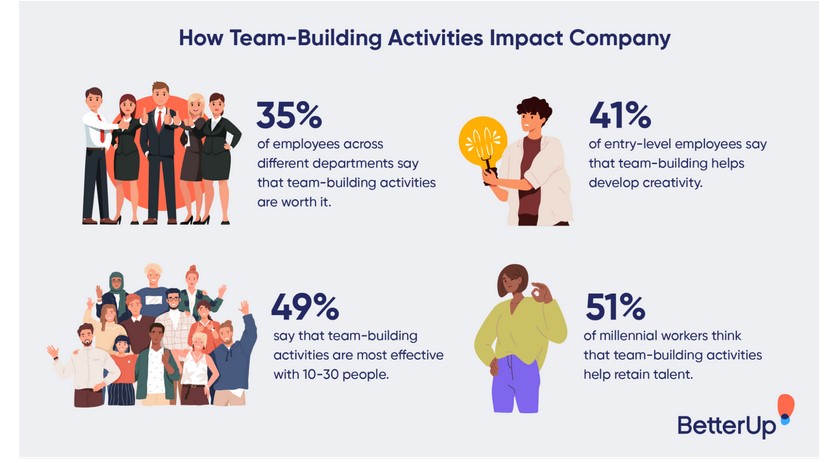Building a cohesive and productive team is essential for any organization’s success. However, creating a successful team is not just about hiring the right individuals.
It’s about understanding the dynamics that influence team behavior and utilizing psychological strategies to enhance team building.
In this article, we will explore the psychology behind team building and provide effective strategies and techniques to improve team dynamics and collaboration.

Effective team building requires an understanding of how individuals interact within a group setting.
The psychology behind team building delves into the various factors that impact team dynamics, including communication, trust, motivation, emotional intelligence, diversity, conflict resolution, and more.
By understanding the psychology behind team building, you can develop strategies to cultivate a positive team culture, enhance communication, and improve overall productivity.
Whether you’re a team leader or a team member, these psychological strategies can help you contribute to a successful and thriving team environment.
Psychological Strategies for Stronger Team Building – The Mind of a Team
Key Takeaways
- Effective team building involves understanding the psychology behind team dynamics.
- Communication, trust, motivation, emotional intelligence, diversity, and conflict resolution are all key factors in building a successful team.
- By utilizing psychological strategies, you can foster a positive team culture and improve overall productivity.
- These strategies can benefit both team leaders and team members.
- Continuously evaluating and improving team dynamics is crucial for sustaining a successful team environment.
The Importance of Team Building in Achieving Success
Effective team building is crucial to achieving success for any organization. As a leader, it’s your responsibility to identify key team success factors and develop strategies to strengthen collaboration and teamwork.
One of the most important aspects of effective team building is establishing a clear sense of purpose and shared goals. A team that is aligned with a common vision and mission is more likely to work together towards achieving success.
Another critical factor in team success is creating an environment of trust and psychological safety.
When team members feel comfortable sharing their ideas and opinions without fear of judgment, it fosters stronger collaboration and creativity.
This is especially important in today’s fast-paced business world, where innovation and adaptability can make or break an organization.
Successful team building also involves recognizing and leveraging the unique strengths and perspectives of each team member.
By embracing diversity and inclusivity, teams can tap into a wider range of ideas and approaches, leading to greater innovation and better problem-solving.
Measuring and evaluating team performance is another key component of effective team building.
Regular feedback and constructive criticism help team members identify areas for improvement and work towards continuous growth and development.
By focusing on these key team success factors and implementing targeted team building strategies, you can create a more productive, collaborative, and successful team that is ready to tackle any challenge.
1. Understanding Team Dynamics and Communication
Team building depends on establishing strong team dynamics and communication. A team’s performance is heavily influenced by how well team members collaborate and communicate with one another.
To foster these type of team dynamics, it’s essential to recognize and understand the psychological aspects that contribute to successful team building.
Team dynamics refer to the various interpersonal relationships and interactions that occur within a team.
These can include communication styles, power dynamics, and social roles. By recognizing and understanding these dynamics, team leaders can work to create a more cohesive and productive team environment.
The Importance of Effective Communication
Effective communication is an essential component of team building. When team members communicate clearly and openly, they can work together more efficiently and effectively.
Communication breakdowns can lead to misunderstandings, conflicts, and a lack of productivity.
To ensure effective communication within your team, it’s essential to establish open lines of communication and encourage team members to share their thoughts and ideas freely.
Team leaders should also provide clear guidelines and expectations for team communication, such as regular check-ins or status updates.
Improving Team Dynamics
Improving team dynamics requires a focus on both individual and group behavior. By understanding each team member’s unique communication style and preferences, leaders can work to create a more collaborative and communicative team culture.
Leaders should also work to establish a sense of psychological safety within the team. This means creating an environment where team members feel comfortable sharing their thoughts and ideas without fear of judgement or reprisal.
The Role of Emotional Intelligence
Emotional intelligence plays a significant role in team dynamics and communication. Leaders should work to cultivate emotional intelligence within the team by encouraging empathy, self-awareness, and social skills.
Team members with high emotional intelligence are better equipped to understand and communicate with their peers. This can lead to improved collaboration and a more harmonious team environment overall.
2. Motivating Your Team for Optimal Performance
Motivation is a powerful tool for achieving optimal team performance. When team members feel motivated, they are more likely to be engaged, productive, and invested in the success of the team.
Here are some psychological strategies for motivating your team:
- Set clear goals and expectations: When team members know what is expected of them, they are more likely to feel motivated to achieve those goals.
- Provide regular feedback: Feedback is essential for driving motivation. Regularly recognize team members for their accomplishments and provide constructive feedback to help them improve.
- Empower your team: Give your team members the autonomy to make decisions and take ownership of their work. This helps them feel valued and trusted, leading to increased motivation.
- Celebrate successes: Recognize and celebrate team achievements. Celebrations can increase team morale and motivation, fueling further success.

“Motivation is the catalyzing ingredient for every successful innovation.” – Clayton Christensen
Keep in mind that motivation is not a one-time fix. It requires consistent effort and attention. By implementing effective team building strategies that cultivate motivation, you can create a dynamic team environment that drives success.
3. Building Trust and Establishing Psychological Safety
Trust is the foundation of collaboration. Establishing psychological safety within your team will enable all members to feel secure and comfortable expressing their thoughts and opinions.
This trust and security will help to enhance team dynamics and promote effective teamwork. Here are some team building techniques to help you build trust and psychological safety within your team:
Encourage Open Communication
Communication is key to building trust and enhancing team collaboration. Encourage your team members to communicate openly, listen actively, and provide clear and honest feedback.
This will foster a culture of open dialogue and make everyone feel valued and heard.
Lead by Example
As a team leader, it’s important to set the tone for trust-building. Lead by example and demonstrate that you trust and respect each member of your team.
This will encourage others to follow suit and establish trust with one another.
Emphasize Collective Success
It’s crucial to emphasize that the success of the team is a collective effort. Celebrate team successes and encourage everyone to work together towards common goals.
This will promote a sense of camaraderie and help build trust and psychological safety within the team.
| Team Building Techniques | Team Collaboration Strategies |
|---|---|
| Encourage open communication | Collaborate on projects and ideas |
| Lead by example | Encourage knowledge sharing |
| Emphasize collective success | Practice active listening |
Implementing these team building techniques will help you establish trust and psychological safety within your team.
By fostering an environment of trust, you will promote effective collaboration, communication, and teamwork, leading to greater overall success.
Got Team Building Games?
![]()
Book a live game show experience today!
Contact us for further details.
For Immediate assistance by text – 917-670-4689
No deposit required. 5-Star Google Rated
We plan and facilitate all activities.
4. The Power of Emotional Intelligence in Team Building
Effective team building involves more than just skills and knowledge. Emotional intelligence (EI) plays a critical role in fostering team collaboration and effectiveness.
EI refers to the ability to recognize, understand, and manage our own emotions, as well as the emotions of others.
When team members possess high EI, they can better connect with one another, empathize, and communicate effectively. This leads to a more positive and productive team dynamic, where everyone feels valued and heard.
“Emotional intelligence is the single biggest predictor of performance in the workplace.” – Daniel Goleman
To cultivate emotional intelligence within your team, consider the following strategies:
- Practice self-awareness: Encourage team members to reflect on their emotions and how they impact their behavior and interactions with others.
This can be achieved through regular self-reflection and mindfulness practices. - Promote empathy: Encourage team members to put themselves in others’ shoes and recognize their perspectives and feelings.
This can be achieved through active listening, open communication, and team-building exercises that promote understanding and collaboration. - Encourage positive communication: Foster a safe and supportive environment where team members feel comfortable sharing their thoughts and feelings.
Encourage constructive feedback, honest communication, and open dialogue to promote trust and respect. - Lead by example: As a leader, model self-awareness, empathy, and positive communication.
Persuade your team to follow your lead, and provide support and guidance when needed.

By cultivating emotional intelligence within your team, you can create a more collaborative and effective work environment that fosters innovation, creativity, and success.
5. Harnessing Diversity in Team Building
Diversity is a crucial aspect of effective team building. It brings together unique perspectives, experiences, and skills that can lead to breakthrough ideas and innovative solutions.
However, diversity can also present challenges if not managed properly.
To harness the power of diversity in team building, it’s essential to create an inclusive culture where each team member feels valued and respected.
Encourage open communication and actively listen to different viewpoints.
One effective strategy is to assign tasks that leverage each team member’s strengths and areas of expertise. This not only maximizes the potential of the team but also fosters a sense of ownership and contribution.
Additionally, consider implementing diversity training to help team members understand and appreciate each other’s differences. This can also help to prevent unconscious bias and stereotyping.
| Benefits of Diversity in Team Building | Challenges of Diversity in Team Building |
|---|---|
| Increased creativity and innovation | Communication barriers due to language or cultural differences |
| Improved problem-solving abilities | Conflict due to differing opinions or values |
| Broader perspective and insights | Difficulty in establishing trust and building relationships |
As you can see, diversity offers many benefits, but it also presents challenges that must be addressed to ensure effective team building.
By embracing diversity and implementing strategies to manage challenges, you can create a collaborative and inclusive team environment that maximizes potential and achieves success.
6. Overcoming Challenges and Conflict Resolution
Effective team communication and collaboration are important factors in achieving team success. However, conflicts and challenges can arise, creating barriers to a harmonious team environment.
To sustain strong team dynamics, it’s crucial to develop strategies to overcome challenges and resolve conflicts.
Understanding the Root of the Conflict
When conflict arises, it’s essential to identify the root cause of the problem. Encourage open and honest communication to understand each team member’s perspective.
By addressing the underlying issues, you can find effective solutions that work for everyone. It’s crucial to focus on the problem, not the person.
Active Listening and Empathy
Active listening involves paying attention to the speaker and understanding their point of view. By practicing active listening, you demonstrate empathy, which can help reduce tension and foster collaboration.
Ask team members to listen actively and avoid interrupting or dismissing their colleagues’ perspectives.
Establishing Ground Rules
Establishing clear ground rules can help prevent conflicts from occurring in the first place. When everyone understands the expectations for communication and collaboration, it becomes easier to avoid misunderstandings that can lead to conflict.
Ground rules can also provide a framework for resolving conflicts when they do arise.
Collaborative Problem-Solving
Collaborative problem-solving involves working together to find solutions to issues. Encourage team members to bring their unique perspectives to the table and avoid discounting any ideas without thorough consideration.
By involving everyone in the problem-solving process, you can create a stronger sense of ownership and commitment to resolving the issue.
Seeking Professional Help
If conflicts persist and cannot be resolved through internal communication and collaboration, seeking external help may be necessary.
Professional mediators or conflict resolution specialists can provide objective guidance and help facilitate productive discussions.

7. Developing Effective Team Communication Strategies
Effective team communication is critical for successful team building. Here are some strategies to ensure your team communicates effectively:
- Active Listening: Encourage team members to actively listen to one another. When someone speaks, make sure they feel heard by repeating back what you heard to confirm understanding.
- Clear Feedback: Provide clear feedback regularly, both positive and constructive. Make sure feedback is specific and actionable.
- Open Dialogue: Encourage open dialogue and create a safe space for team members to share their ideas and concerns. Make sure all team members feel comfortable speaking up.
It’s also important to establish clear channels of communication. Whether it’s through email, instant messaging, or video conferencing, make sure everyone knows how to contact one another and what to do in case of an emergency.
Another effective strategy is to establish communication norms or guidelines. These guidelines can include expected turnaround times for emails, how often team meetings should take place, and what information should be included in reports.
By establishing clear expectations, you can reduce miscommunication and ensure that everyone is on the same page.
Example of Communication Norms
| Communication Type | Expected Turnaround Time |
|---|---|
| 24 hours | |
| Instant Messaging | 2 hours |
| Video Conferencing | 1 hour |
By following these strategies and establishing clear communication norms, you can ensure that your team communicates effectively, leading to stronger collaboration and increased success.

8. Encouraging Collaboration and Teamwork
Successful team building requires a strong emphasis on collaboration and teamwork.
By working together, team members can leverage their collective knowledge, skills, and experiences to achieve common goals and objectives. Here are some strategies to foster collaboration and teamwork within your team:
- Encourage open communication: Establish an environment where team members feel comfortable sharing ideas, asking questions, and giving feedback.
Encourage active listening, clear feedback, and open dialogue to ensure that everyone has a voice. - Set common goals: Define specific, measurable, and achievable goals that everyone on the team can work towards. This will help ensure that everyone is aligned and working towards a common objective.
- Celebrate successes together: When the team achieves a milestone or completes a project, take time to celebrate together. This helps build a sense of camaraderie and reinforces the team’s collective achievements.
- Encourage knowledge sharing: Encourage team members to share their knowledge and expertise with one another. This promotes continuous learning and development, and helps ensure that the team is working at the highest possible level.
- Hold regular team-building activities: Plan regular team-building activities to help foster a sense of camaraderie and teamwork.
These activities don’t have to be elaborate, but they should provide an opportunity for the team to come together and build relationships outside of work.

“Coming together is a beginning. Keeping together is progress. Working together is success.” – Henry Ford
By encouraging collaboration and teamwork, you can create a positive team culture that fosters mutual respect, trust, and a commitment to excellence.
This not only enhances team performance but also contributes to the overall success of the organization.
9. Evaluating and Improving Team Performance
Effective team building and continuous improvement practices go hand in hand. Evaluating the performance of your team and identifying areas for improvement is crucial for any successful organization.
Here are some team success factors to consider as you evaluate team performance:
- Define clear goals: Ensure that the team understands the goals and expectations, including specific targets and timelines.
- Measure performance: Use objective metrics to measure performance and identify areas for improvement.
- Provide feedback: Provide prompt and constructive feedback to team members that encourages improvement and growth.
- Implement improvement strategies: Collaborate with your team to develop and implement strategies for improvement based on the identified areas.
Evaluating Team Performance
To evaluate team performance, you need to establish metrics for success. These metrics may include:
| Metric | Description |
|---|---|
| Productivity | The amount of work completed by the team in a specific period. |
| Quality | The quality of the work produced by the team. |
| Communication | The ability of the team to communicate effectively with one another. |
| Creativity and Innovation | The team’s ability to generate unique ideas and approaches to problem-solving. |
| Collaboration | The ability of the team to work together to achieve common goals. |
It’s also essential to gather feedback from team members themselves. Regular feedback from team members can help identify areas for improvement and provide insights into how team dynamics can be enhanced.
Improving Team Performance
Once you have identified areas for improvement, it’s time to implement strategies to address them. Here are some effective team building techniques to improve team performance:
- Encourage collaboration: Foster a culture of collaboration, where team members feel comfortable sharing ideas and supporting one another.
- Promote knowledge sharing: Encourage team members to share their expertise and knowledge to enhance team performance.
- Provide training and development opportunities: Invest in the growth and development of your team members to improve their skills and knowledge.
- Celebrate success: Recognize and celebrate the team’s achievements to boost morale and motivation.
By regularly evaluating team performance and implementing improvement strategies, you can ensure that your team is operating at their best and achieving their full potential.
Team building is a continuous process of improvement, and by prioritizing team success factors, you can create a high-performing team culture.
10. Sustaining Strong Team Dynamics
Building strong team dynamics requires ongoing effort and attention. To ensure long-term success, it’s important to implement effective team building strategies that foster collaboration, productivity, and positive team culture.
Emphasize the Importance of Team Dynamics
To sustain strong team dynamics, it’s important to emphasize the crucial role that team dynamics play in overall success.
Encourage team members to prioritize teamwork and collaboration and acknowledge their contributions to the team’s success.
Regularly Evaluate Team Performance
Monitoring and evaluating team performance is key to identifying areas for improvement and maintaining strong team dynamics.
Regularly review team goals and progress, provide constructive feedback, and implement continuous improvement practices.
Promote Open Communication
Effective communication is crucial for maintaining strong team dynamics. Encourage open dialogue, active listening, and clear feedback to foster a collaborative team environment.
Address any conflicts or challenges promptly and work collaboratively to find solutions.
Encourage Diversity and Inclusivity
Diversity brings unique perspectives and strengths to a team. Encourage inclusivity and create a safe space for team members to share their ideas and opinions.
Recognize and celebrate diverse perspectives and contributions to foster a positive team culture.
Focus on Team Success Factors
Identify and prioritize team success factors, such as clear goals, effective leadership, and positive team culture.
Work collaboratively to develop and implement strategies to promote these factors and sustain strong team dynamics.
Provide Opportunities for Team Building
Regularly provide opportunities for team building activities, such as team lunches, off-site events, and team-building exercises.
These activities can strengthen team bonds, foster collaboration, and promote a positive team culture.
Celebrate Team Achievements
Celebrate team achievements, big and small, to reinforce a positive team culture and recognize the contributions of each team member.
Celebrating achievements also promotes a sense of pride and commitment to the team’s goals and success.
By implementing effective team building strategies and fostering a positive team culture, you can sustain strong team dynamics and achieve long-term success.

team-building-impact-statistics
Frequently Asked Questions – Team Building Psychology

frequently asked questions
What is team building psychology?
Team building psychology is the study of the psychological strategies and techniques that can enhance team dynamics and collaboration.
It involves understanding the mindset of a team and implementing effective strategies to improve overall team performance.
Why is team building important for success?
Team building is crucial for achieving success because it fosters effective communication, collaboration, and trust among team members.
It creates a positive team culture and improves overall team dynamics, leading to increased productivity and goal attainment.
What are team dynamics and why are they important?
Team dynamics refer to the psychological and interpersonal relationships among team members. They are important because they influence team performance, communication, and collaboration.
Understanding team dynamics can help identify areas for improvement and enhance overall team effectiveness.
How can I motivate my team for optimal performance?
Motivating your team for optimal performance involves understanding their individual needs, setting clear goals, and providing incentives and recognition for their achievements.
It is important to create a supportive and empowering environment that encourages growth and fosters a sense of purpose.
How can I build trust and establish psychological safety in my team?
Building trust and establishing psychological safety in a team can be achieved through open and honest communication, active listening, and demonstrating empathy.
Creating a safe space for team members to share their ideas and opinions without fear of judgment or retribution is essential for fostering collaboration and trust.
How does emotional intelligence contribute to team building?
Emotional intelligence plays a significant role in team building as it enables team members to understand and manage their own emotions, as well as empathize with and respond to the emotions of others.
Cultivating emotional intelligence within your team enhances communication, collaboration, and overall team effectiveness.
How can I harness the power of diversity in team building?
Harnessing the power of diversity in team building involves recognizing and valuing the unique perspectives, backgrounds, and skills that each team member brings.
Creating an inclusive environment that encourages diverse viewpoints fosters creativity, innovation, and better decision-making within the team.
How can I resolve conflicts within my team?
Resolving conflicts within a team requires effective communication, active listening, and problem-solving skills.
Encouraging open dialogue, seeking to understand different perspectives, and finding mutually agreeable solutions are key to overcoming challenges and maintaining a harmonious team environment.
What are some effective team communication strategies?
Effective team communication strategies include active listening, clear and concise messaging, regular and constructive feedback, and encouraging open and transparent dialogue.
It is important to establish clear communication channels and promote a culture of open communication within the team.
How can I encourage collaboration and teamwork in my team?
Encouraging collaboration and teamwork requires creating a culture that values and rewards collective effort.
Establishing shared goals, promoting knowledge sharing, facilitating cross-functional collaboration, and recognizing and celebrating team achievements are effective ways to foster a collaborative team environment.
How can I evaluate and improve team performance?
Evaluating and improving team performance involves setting clear performance metrics, regularly monitoring progress, providing constructive feedback, and implementing continuous improvement practices.
It is important to identify areas for improvement, celebrate successes, and support the professional growth of team members.
How can I sustain strong team dynamics in the long term?
Sustaining strong team dynamics requires ongoing effort and attention. It involves fostering a positive team culture, facilitating team bonding activities, promoting open communication and trust, and addressing conflicts and challenges proactively.
Regularly revisiting team goals and objectives and providing opportunities for professional development and growth are also important for sustaining strong team dynamics.





